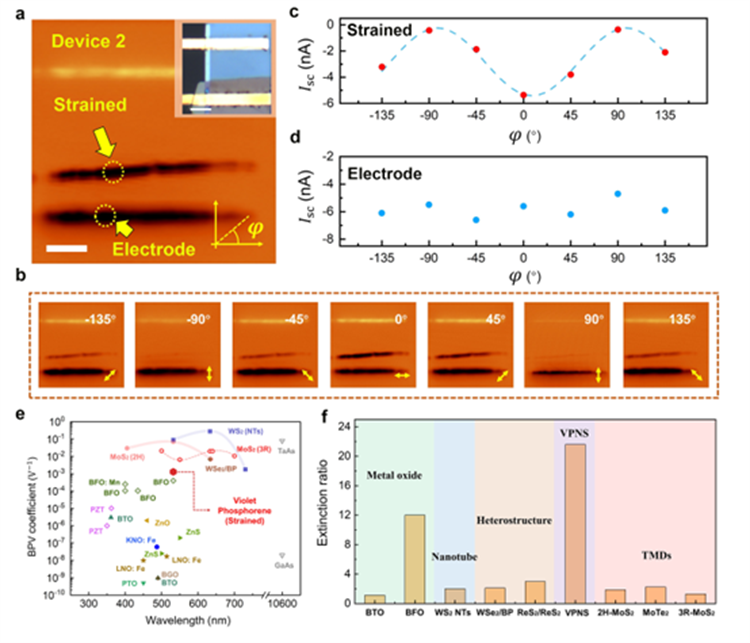NKU Team Achieves Strong Bulk Photovoltaic Effect in the Phosphorene System for the First Time
The team led by Prof. Liu Zhibo and Prof. Tian Jianguo of Nankai University, in collaboration with the team led by Zhang Jinying of Xi’an Jiaotong University, has made important progress in the field of optoelectronic study of strained two-dimensional materials. The strong flexo-photovoltaic effect in violet phosphorene nanosheets was successfully induced by applying strain using the boron nitride nano-edges. The related results were published in the top international journal ACS Nano, entitled “Strain-Prompted Giant Flexo-Photovoltaic Effect in Two-Dimensional Violet Phosphorene Nanosheets”.
The photodetector is a core component in the field of photoelectric technology. Traditional silicon-based photodetectors face challenges in terms of size reduction and performance enhancement, and the emergence of two-dimensional materials offers new ideas for cracking this problem. In recent years, attention has been paid to the study of the optoelectronic properties of strained two-dimensional materials. The lattice and energy band structure of two-dimensional materials can be effectively regulated through strain engineering, so as to obtain novel optoelectronic properties. The bulk photovoltaic effect (BPVE) is a spontaneous photoelectric effect not constrained by the Schockley-Queisser (SQ) limit and photocurrent can be generated through the uniform irradiation of a single non-centrosymmetric. This can be achieved in flexible two-dimensional materials through strain engineering. This strategy has been successfully applied to two-dimensional material systems such as MoS2, providing a new idea for the design of photoelectric devices. It is expected to operate without the limitations of traditional photoelectric conversion efficiency. However, there is still a lack of research on strained phosphorene systems.

Figure 1. Lamination deformation of the violet phosphorene nanosheet on the boron nitride nano-edge and flexo-photovoltaic effect caused by uniaxial strain.
The team led by Prof. Liu Zhibo and Prof. Tian Jianguo and the team led by Prof. Zhang Jinying successfully induced the strong flexo-photovoltaic effect in violet phosphorus through strain engineering using the boron nitride nano-edges. The research team found that this particular BPV effect is caused by the inversion symmetry breaking resulting from the uniaxial strain on the violet phosphorene nanosheets, and confirmed the relationship between the flexo-photovoltaic effect and the strain gradient through thickness-dependent photoelectric response study. By systematically optimizing the height of boron nitride and the thickness of the violet phosphorene nanosheet, the research team achieved a BPV coefficient up to 1.3×10-3V-1 and a polarization extinction ratio of 21.6, which is the largest polarization extinction ratio reported in BPV materials to date. The results reveal the relationship between the flexo-photovoltaic effect and the strain gradient in low-dimensional materials, and stimulate exploration of photoelectronic phenomena in the strain engineering of two-dimensional materials. This will promote the application of two-dimensional materials in the field of photoelectric detection.

Figure 2. Comparison of polarization-dependent flexo-photovoltaic effect photocurrent and performance of the strained violet phosphorene nanosheets devices.
Nankai University doctoral students Sun Ruoxuan and Hu Zhen are the co-first authors, Prof. Liu Zhibo and Prof. Zhang Jinying are the co-corresponding authors. The School of Physics of Nankai University is the employer of the first authors.
URL: https://pubs.acs.org/doi/10.1021/acsnano.4c02821
(Edited and translated by Nankai News Team.)









